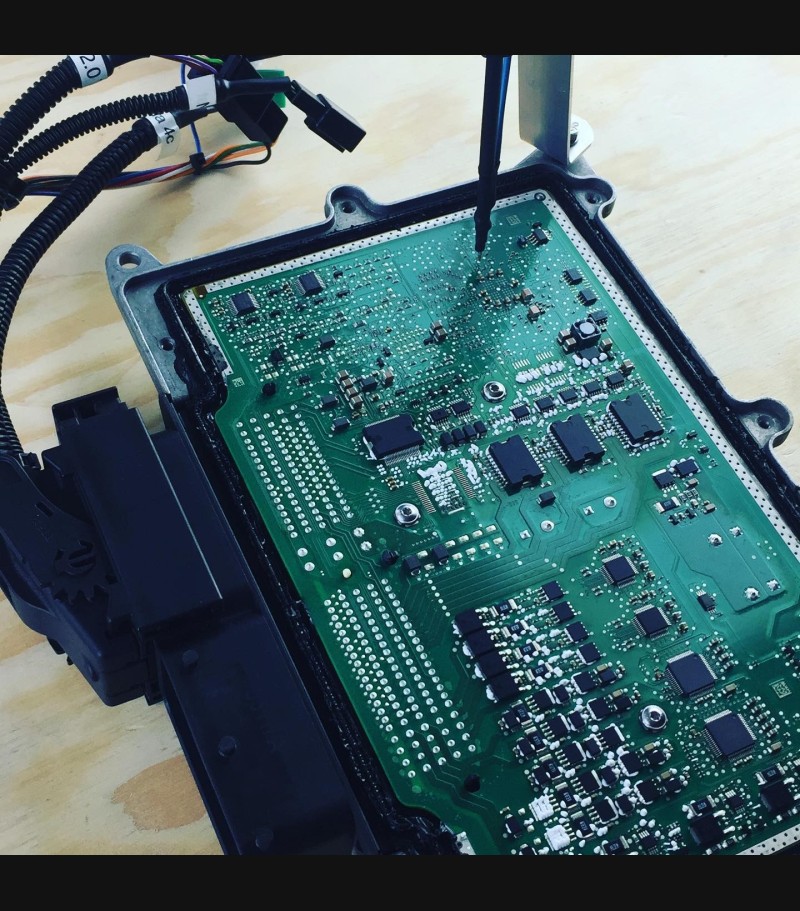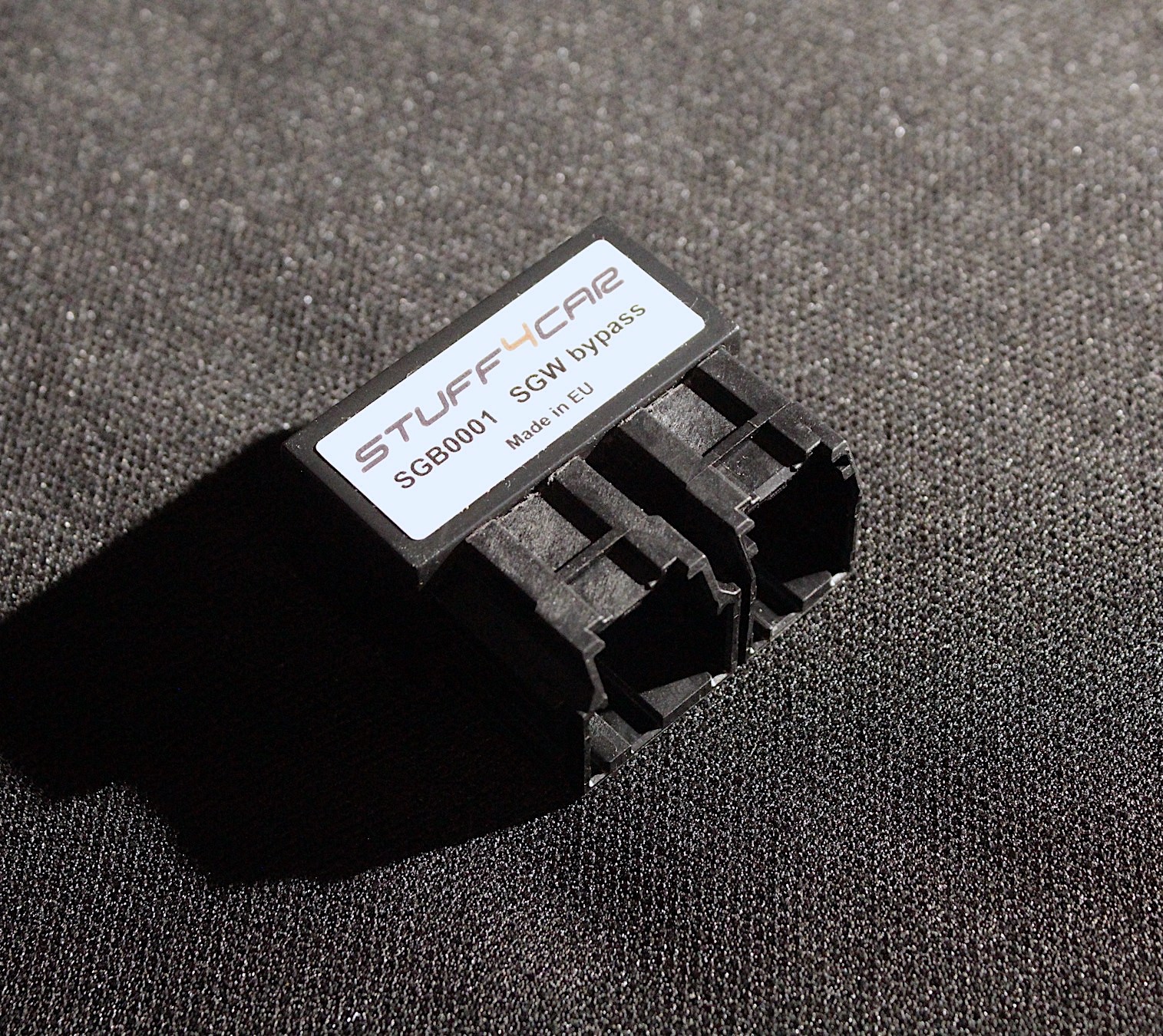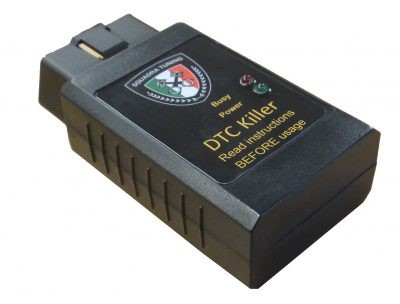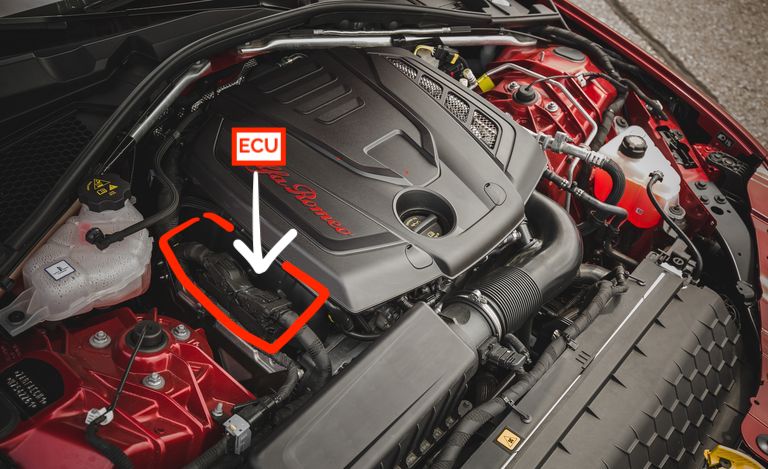




Security policy

Delivery policy

Return policy
Squadra-Tuning - tuned here in the US by Alfissimo
READ THIS IN ITS ENTIRETY BEFORE ORDERING
The 2.0 Turbo MultiAir engine in the Giulia/Stelvio has been put on the market with 280 hp and 400 Nm (295 ft-lb). However, the rolling road tests show very different values. Everything between 440 (324.5 ft-lb) and 460 (339.3 ft-lb) Nm and between 280 and 310 (!) Hp is possible. The first-produced Giulia’s were shown to have the most Hp/Tq.
Despite these major differences, the big question for us was how much extra we could extract from the motor. After a lot of research and testing, we can only say that there is not much to gain Hp wise but much more in Torque. With some turbo pressure increase in the mid speed range, about 20 to 30 Nm is added. By advancing the ignition at higher speeds around 10 to 12 hp. Increasing turbo pressure at higher revs unfortunately brings NOTHING extra, except for an increased risk of ignition problems due to too much back pressure from the catalyst.
Using the highest quality/octane fuel is a must to achieve the best performance.
That said “improvements” are achieved in other areas... See below:
DNA settings
The torque and power in N and D position are the same as standard. In the A-position it is considerably lower.
With our tuning program we have put the old 200 hp to 230 hp setting in the A-position. The N position is a happy medium between The A and D positions. The D-position achieves the maximum achievable performance.
Speed limiter
The Giulia is limited at top speed. At 240 km/h, 149mph. While the entire German industry limits at 250 km/h, 155mph.
Incomprehensible so we increased the limit to 270 km/h, 167.7 mph.
EGR
The 2.0 MultiAir engine is equipped with both an external and internal EGR control. The external system is really outside the engine. Exhaust gases are drawn off at the outlet and returned to the inlet via a water cooler. EGR is never good for the technology and the flexibility of the engine. That is why we would prefer to switch it off.
So now the EGR valve does not work at all and in fact is later removed by the manufacturer from these cars.
The same applies to the internal EGR. This is accomplished by slightly opening the MultiAir system during the exhaust stroke, controlled by the MultiAir system. For example, a small amount of exhaust gas flows into the inlet, which is sucked in again with the next intake stroke. The operation of this can also not be monitored or read on the diagnostic equipment. We have found how we can disable this in the software. In-fact newer cars do NOT even have EGR equipment.
Speed limiter when the car is stationary
Alfa drivers sometimes tend to install a different exhaust. Every now and then they would like to show off their exhaust note. By default that does not work so well because the revs are limited to 3500 revs.
We have adjusted it to the normal level of 6,000 rpm. Enjoy Sounds!
Modified intercooler strategy
The 2.0T engine is equipped with a water-cooled intercooler system. In the intake manifold is a heat exchanger through which coolant is pumped. The colder this coolant is, the lower the inlet temperature will be. And the lower the inlet temperature, the more oxygen the air will contain, which directly translates into more torque and power.
However, the Alfa Romeo engineers have not done their best to make the coolant as cool as possible. By changing the strategy of the cooling water pump, the liquid cools down faster and to a lower temperature. Obviously, this requires air into the intercooler. So at lower speeds there is not much to be gained from it but as soon as the speeds rise, an extra buffer is built up in the intercooler cooling system so that when the real power is used, more torque and power will be available.
Test drives have shown that the inlet temperature was about 10 degrees lower than standard. Which equates to about 3% more oxygen. In theory, that produces about 14 Nm and 9 hp more. This is NOT measurable on a rolling road due to insufficient cooling/wind.
Temperature limiters
Despite the relatively small torque and power gain, we still want to protect the extra technology the vehicle is equipped with. The software offers great possibilities for this. And especially in the cold state. Depending on the oil temperature, we have limited the maximum torque and power. The full potential is only present when the oil temperature has reached 70 degrees (similar to the QV and it's race-mode on a cold engine).
High inlet temperatures (measured in the intake manifold, the air that really matters) increase the chance of pinging. From 65 degree C˚/149˚F inlet temperature, we allow the maximum torque and power to decrease. This 65 C˚/149˚F is not achieved under normal circumstances. but only with a combination of warm weather and long-term full load can this occur. And only then is the extra protection useful.
We have also done adjustments with the water temperature limit. By default, it intervenes from 110 degrees C˚/230˚F. We find that a bit late considering the normal working temperature of around 85-88 C˚/185-190.4˚F degrees. We have lowered that to 104 C˚/219.2˚F.
As stated, we achieve the gains by advancing the ignition at higher speeds. RON98 fuel/93 octane is the recommended fuel for the stated hp/tq gains. We do hereby prefer RON98 from well known fuel companies. For example Shell V-power We do not recommend RON98 fuel from a “budget pump”. 91 Octane may decrease performance slightly depending on quality.
USA: 91-93+ Octane from Top tier gas stations.
Start /stop strategy
We completely switch off the start / stop system of course.
- Pedal mapping has not been adjusted, combined with the tune it is not needed. It's very balanced in all settings
On a 280 bhp tuning ST did not do anything to the throttle response.
In a car without Race mode ST's opinion (and we completely agree) is that the throttle response is very well balanced in all settings. Squadra does not like aggressive throttle responses, the car becomes uncontrollable/jumpy/erratic. When you are driving on smaller country roads or on mountain roads it's very important that you are able to control the exact amount of torque.
* Race-Mode
For cars with Race-mode it's different. As you know when Race is activated in PROXI the engine is functioning like it's in Normal. Regardless if the DNA setting is on A, N, D or Race. However the gearbox still does see the difference between A, N, D and Race.
You should really realize that the shifting behavior from the gearbox has a very big influence on the driving experience.
* Race-Mode can be tuned in for those that have it installed or will install in the future. The tune does not come with race mode installed. The vehicle owner must install the race mode switch, enable race mode with Multiecuscan.
After a long road trip to the Italian Alps ST decided to maintain the Normal throttle response for cars with activated Race mode. So the throttle response is like in Normal in all settings from the DNA + Race switch. That really gives the best dosable torque and power.
Sailing/Coasting (from September 2023)
Sailing or Coasting is the phenomenon that when you release the throttle in the A position and depending on the Emission version also in the N position, the drivetrain is disconnected and the engine speed drops to idle. The car then actually rolls out with, as it were, a disengaged clutch. When you accelerate, the drivetrain is reconnected and you continue driving as usual. This is experienced by our customers as an irritating strategy. The car does not brake on the engine and coupling the drivetrain causes abruptness. That’s why we disable this strategy with the Massimo. This ensures that the car slows down with the engine and the abruptness when accelerating is gone.
Error message “U1008 LIN bus 1” made active (from September 2023)
Unfortunately, this error message becomes more common as the car ages. The problem, however, is that the driver does not see this because the malfunction light does not come on. When reading faults with diagnostic equipment, the error is displayed. But most engineers have no idea what “LIN bus 1” refers to. In practice, this is then deleted for convenience. Too bad, because this error message has major consequences. LIN bus 1 is the communication line to the circulation pump of the water-cooled intercooler. When the fault occurs, the pump stops and the inlet temperature will rise so high that the power is regulated again. We adjust the priority status from “not important” to “important”, resulting in an illuminated fault light. This way the driver is informed and action can be taken.
The remedy for the problem is to replace the relay that switches on the intercooler pump in question.


There is no need to remove battery lead. Let vehicle sit for 2 minutes before unplugging ECU.
Remove 1 nut and 3 bolts holding ECU in-place (note the ground lead on top nut, do not forget to place back on.
Package well and use sturdy box to ship.

*Tuning is a non-returnable product that is classified under our terms and conditions as "electronic components". There are no returns. No exceptions.
Squadra Tuning is not the umpteenth company that has plunged into the magical world of chip tuning. We do not purchase modified software from large software manufacturers whose quality always leaves something to be desired, but we develop all software in-house. That rightly makes Squadra Tuning a unique and highly valued player in this world.
Chip tuning
Chip tuning started as a hobby. Squadra Tuning originated, actually by accident, in the early 2000s. However, my activities in the world of chip tuning date back to before that time. It all started in 1991 during an internship at Alfa Romeo Netherlands. It was there that I first came into contact with chips and their modification. At that time, Alfa Romeo NL had a chip for the Alfa 33 16v. It was a so-called 004 version. This chip ensured that the car held less cold and had less tendency to ping on 95 RON petrol. As an intern I carried out those modifications.
Software program
From that moment on, the subject started to fascinate me. After the internship year, another year of graduation followed. I studied at the HTS automotive technology in Apeldoorn and that meant a graduation assignment of a decent standard. We proposed “software engine management influencing”. In short “chip tuning”. For this purpose, a computer-controlled engine test stand was built for the first time. We could read all parameters on a PC. In addition, we obtained some 'inside information' about the exact data programmed into a chip. Together with this data and some specially developed hardware and software, the secrets of engine management were discovered. We could see exactly how the program reads from the chip. This graduation assignment also laid the foundation for a software program that makes it possible to visualize the data of a chip in a simple manner. This, together with the possibility to easily adjust this data, was the start of a software program that is still being further developed to this day. This program is used by two professional chip tuners in the Netherlands and the HTS autotechniek itself.
engine management
After graduating, I worked for a little over a year in the racing circus at Zandvoort. In that time again learned a lot about engine management systems, chip tuning and also engine technology. Then I ended up at Fiat Auto Netherlands, the importer of Fiat, Alfa Romeo and Lancia. There I fulfilled the function of trouble shooter. It was here that I really got to know the technology of the car and the problems that came with it. In addition, the knowledge of the real operation of the engine management system gave a lot of support. However, I could not suppress the urge to do more with the knowledge about chip tuning and programming special chiptune software.
So I have grown along with the developments in this field. Know “the world” well, the possibilities, the problems, but also the messes and how not to do it. My hobby was increasingly compromised by the philosophy of Fiat Auto NL. They asked me to stop with my hobby. This prompted me to look further and so I said goodbye. After that I worked at an Alfa Romeo dealer as a workshop manager and THE technical man for the more complicated problems.
Squadra Tuning
I was able to continue my hobby and see here: Squadra Tuning got a sequel. From 1 August 2001 his work as workshop manager also came to an end. From then on I started to focus entirely on chip tuning for the Alfa Romeo brand, which we love so much. That's how I turned my hobby into my profession. Squadra Tuning is therefore also a fact from that date.
Squadra Tuning has now grown into a global company. Alfa Romeo's are already on the road in more than 45 countries with our software. From Canada to New Zealand, from Norway to South Africa.
Our goal: to offer chip tuning in a fun and clear way, based on our technical knowledge and background and not making empty (marketing) promises. We want to inform you as a consumer honestly about the possibilities and impossibilities of chip tuning. Our specialization makes us a unique and renowned player in the (international) tuning world.